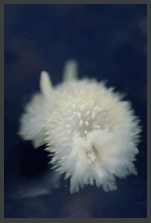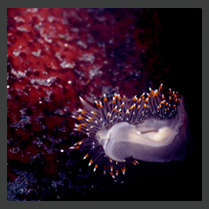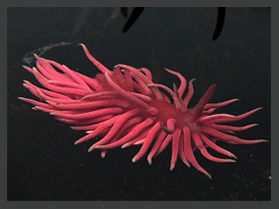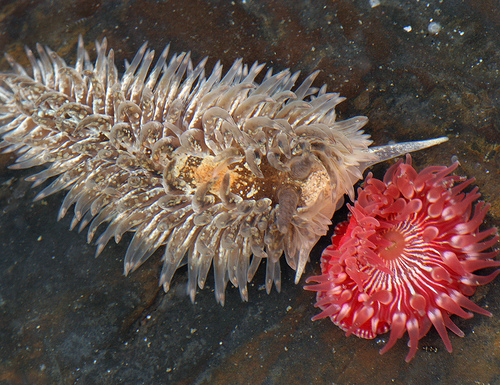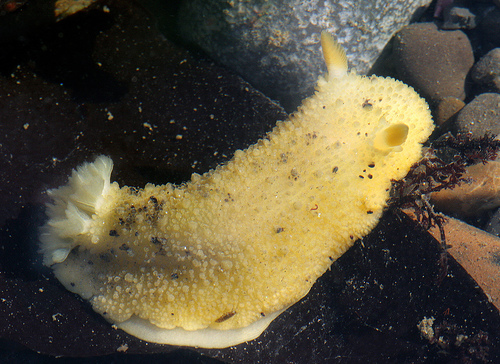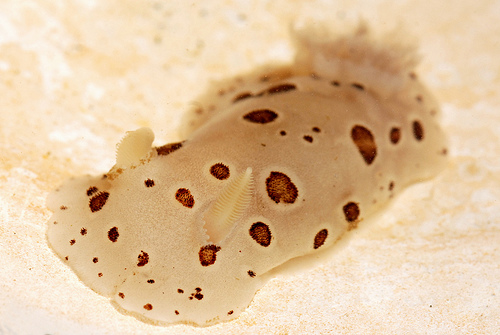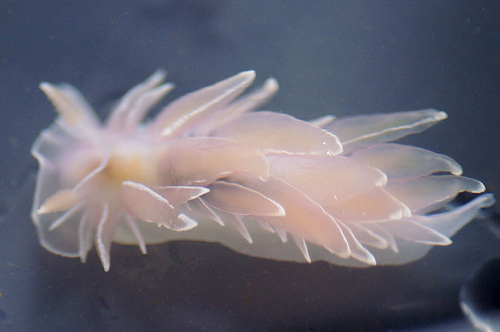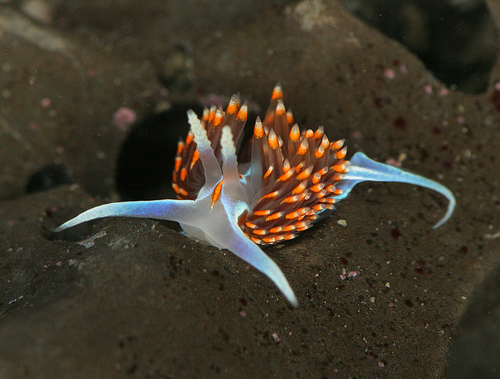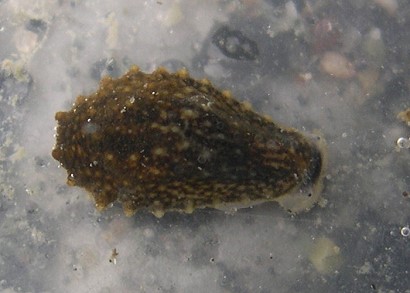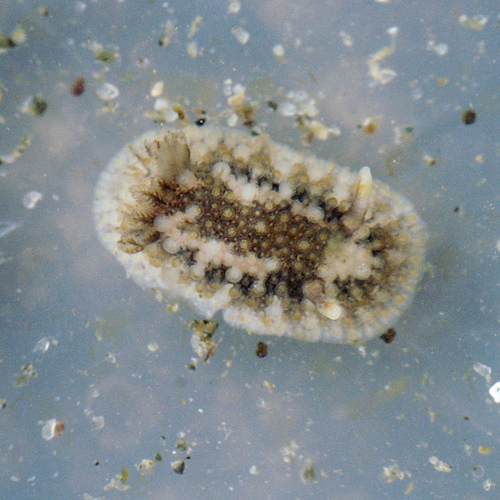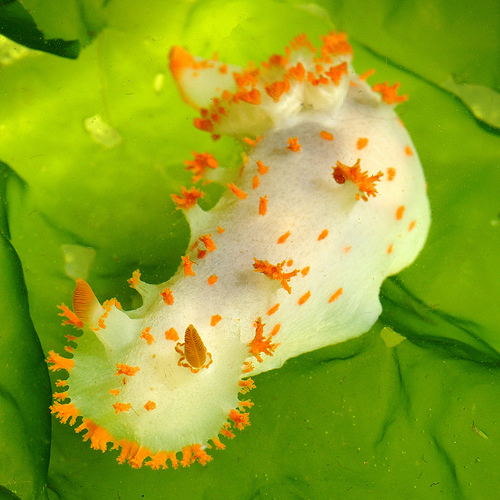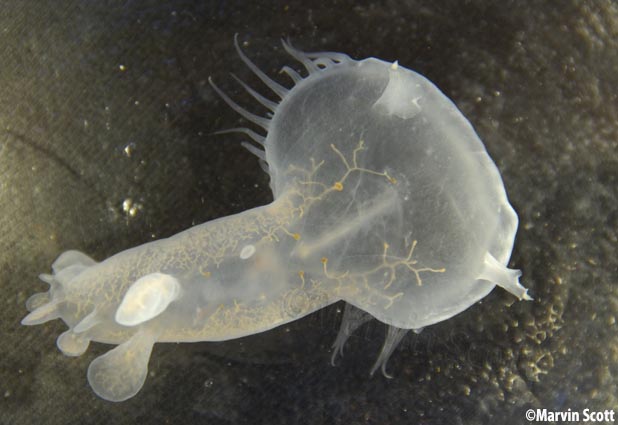
|
|||
| Shaggy Mouse Nudibranch | Description: Pink to gray to white body with numerous grayish | ||
| brown cerata covering all but the center of the dorsal surface. | |||
| Size: To 60 mm. | |||
| Natural History: Intertidal to 671 m. On protected rocky and | |||
| sandy shores and in eel grass. Feeds on anemones. | |||
| Range: Alaska to southern California. | |||
| Location of Observation: Fox Island. | |||
|
|||
| |
Monterey Dorid | Description: Yellow body with black spots. Spots are not restricted | |
| to the dorsum and extend to some of the tubercles. Spots are | |||
| randomly distributed and of various size. Branchial plume is grayish- | |||
| yellow. | |||
| Size: To 150 mm. | |||
| Natural History: Rocky intertidal to 50 m. Feeds on the sponge | |||
| Halichondia and others. | |||
| Range: Alaska to San Diego, California. | |||
| Location of Observation: Argyle Creek and Tongue Point. | |||
|
|||
| Yellow-Edged Nudibranch | Description: Bright white body with bright lemon-yellow margin. | ||
| Tubercule are also tipped with yellow, sometimes forming a spoted | |||
| ring just inside of the margin. Rhinophores are white. | |||
| Size: To 45 mm. | |||
| Natural History:Rocky intertidal to 45 m. Feeds on several | |||
| species of sponge. | |||
| Range: Alaska to Point Eugenia, Mexico. | |||
| Location of Observation: Friday Harbor. | |||
|
|||
| No Common Name | Description: Variable color ranging from cream to green to brown | ||
| with two pairs of light brown lines running along the body from | |||
| rhinophores to tail. Has six pairs of tufted gills. | |||
| Size: To 33 mm. | |||
| Natural History: Feeds exclusively on Aglaophenia, a feather | |||
| hydroid. We found one example in an eel grass filled tide pool. | |||
| Range: Vancouver Island to Baja California. | |||
| Location of Observation: Sokal Point. | |||
|
|||
| Ringed or Leopard Nudibranch | Description: Light brown or gray to white with light to dark brown | ||
| spots or rings. Spots are randomly distributed and of various size. | |||
| Branchial plume is tripinnate. | |||
| Size: To 100 mm. | |||
| Natural History: Feels on the sponge species Halichondria and | |||
| Haliclona. Rocky intertidal to 35 m. | |||
| Range: Alaska to Baja California. | |||
| Location of Observation: Tongue Point. | |||
|
|||
| Frosted or White-Lined Nudibranch | Description: White to gray to pink translucent body. Cerata are | ||
| large, full, and leaf-like and edged in white. | |||
| Size: To 180 mm. | |||
| Natural History: Rocky intertidal to 35 m. Feeds on anemones, | |||
| ascidians, hydroids, bryozoans, and snails- which it eats by cracking | |||
| the shell open with its jaws. | |||
| Range: Alaska to San Diego, California. | |||
| Location of Observation: Friday Harbor. | |||
|
|||
| White Bubble Shell | Description: Visible shell covered by a translucent brown to | ||
| yellow speckled periostracum; body is semi-translucent light brown | |||
| with brown to yellow speckles. | |||
| Size: To 24 mm. | |||
| Natural History: Restricted to the intertidal areas of bays; on and | |||
| just below surface of muddy to sandy sediment and among eel grass. | |||
| Lays eggs on sandy bottom shores in July. | |||
| Range: Alaska to the Gulf of California. | |||
| Location of Observation: False Bay and Fox Island. | |||
|
|||
| Opalescent Nudibranch | Description: White to yellow translucent body with blue, orange, | ||
| and white stripes. Cerata are pink to orange to brown and end with | |||
| orange bands and white tips. Rhinophores are horn-like. | |||
| Size: To 50 mm. | |||
| Natural History: Intertidal to 35 m. In eel grass beds, docks, | |||
| rocky shorelines, and mud flats. Feeds on hydroids, anemones, | |||
| ascidians, mullusks, and other aeolids. | |||
| Range: Alaska to Baja California. | |||
| Location of Observation: Cattle Point, Friday Harbor, and | |||
| Fox Island. | |||
|
|||
| Leather Limpet | Description: Black to gray to brown body, most often mottled. | ||
| Bumpy dorsal surface. Pear shaped body resembling a limpet. | |||
| Size: To 15 mm. | |||
| Natural History: Low rocky intertidal, on seaweed and rocks. | |||
| Range: Alaska to northern California. | |||
| Location of Observation: Fox Island and Tongue Point. | |||
|
|||
| Barnacle-Eating Dorid | Description: Multicolored patterned body in dark brown, cream, | ||
| and tan. Tubercles are club-shaped and branchial plume is short and | |||
| forms a semicircle. | |||
| Size: To 20 mm. | |||
| Natural History: Intertidal to shallow subtidal. Rocky shoreline to | |||
| muddy substrate. Feeds on barnacles and encrusting | |||
| bryozoans. | |||
| Range: Alaska to Baja California. | |||
| Location of Observation: Fox Island. | |||
|
|||
| Red Nudibranch | Description: Bright scarlet red body, branchial plume, and | ||
| rhinophores. Branchial plume is short and forms a circle. | |||
| Size: To 30 mm. | |||
| Natural History: Rocky intertidal to 30 m. On or near the red | |||
| sponges on which it feeds- Acarnus, Plocamia, Esperiopsis, and | |||
| Ophlitaspongia. Its color, and that of its eggs, is derived from that | |||
| of its prey. | |||
| Range: Alaska to southern California. | |||
| Location of Observation: Cattle Point and Fox Island. | |||
|
|||
| Orange-Spotted or Clown Nudibranch | Description: White translucent body with bright orange tubercles. | ||
| Rhinophores, frontal veil, and branchial plume are white and tipped | |||
| with orange to red. | |||
| Size: To 150 mm. | |||
| Natural History: Intertidal to 30 m. Most often in rocky areas with | |||
| tide pools. Feeds on bryozoans. | |||
| Range: Alaska to Baja California; Japan. | |||
| Location of Observation: Friday Harbor and Tongue Point. | |||
|
|||
| Hooded Nudibranch | Description: Yellow-tinged to green-tinged white transparent | ||
| body. Cerata are large, flat, and lobe-shaped and the digestive organ | |||
| is visible within them. Has a large oral hood with tentacle fringe. | |||
| Size: To 100 mm. | |||
| Natural History: Intertidal to shallow subtidal. Feeds on | |||
| small crustaceans and hood is used for capturing prey. | |||
| Range: Alaska to Baja California. | |||
| Location of Observation: Friday Harbor. | |||


